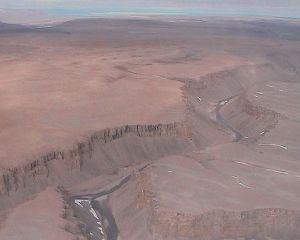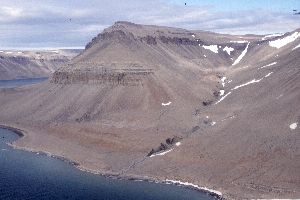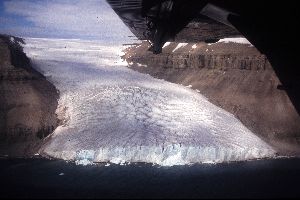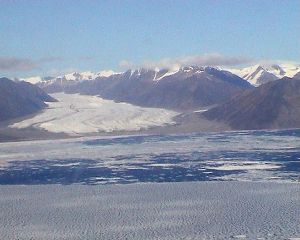Tues Aug 3rd:
I wake groggy but rested. Alfred is outside, on the phone to Borek – they are coming today about 1pm. Still time for coffee and to make a final bannock. I don’t see any foxes outside, they were quiet yesterday, likely roaming farther afield, learning the skills of a hunter. A high overcast pales the sky but its pretty clear, I can see Ellesmere Island well. Little wind, I’m glad as I hope for a smooth flight out.
But its 11am when a plane appears from the north-east, coming from the direction of Grise Fiord. Pilots, Paul and Will are early but heck, any pick up after 2 days delay is a good pick up and I’m glad to see them. Hurriedly, we pack the few remaining odds and ends, shut and bar the hut door for the last time. It was a convenient place to shelter, I’m glad we could use the space especially on some of those long rotten weather stretches.


The twin otter bumps down the gravel strip and after an incredibly short take off, we are air born. It’s a low level flight, great for viewing, along the north coast of Devon – first over Sverdrup Inlet then across huge, deep and spectacular Bear Bay. The breadth of Jones Sound is evident for the first time, from the air – ice is jammed up against the north shore of Devon, only the middle of the Sound would allow for boat passage. No wonder so many explorers had problems with wood ships in the short ice free season.
The desolate uplands make up for the empty wildlife with fantastic landscapes: wind weathered hoodoos rim deep eroded gullies. Cracks reflect wet run off from still existing snow patches. Flat lands look like textured alligator skin, rumpled dry and harshly weathered. It’s the Empty Quarter, like to a hot Saudi sand desert.
After about 50 minutes flying over Devon, the south coast becomes visible. We hope to land at Beechy Island, a second attempt after the aborted effort 4 weeks ago. Dark grey fog shrouds our hoped for landing, a second attempt at the Franklin - Beechy Island site. But this time, there is a break in the sky, we fly low by twice, Paul and Will inspecting the strip closely. The plane drops like a stone and we are down!
What a horrendous place! Beechy Island is actually linked to Devon by a thin ½ km rock spit. A wind whips the bay waters to a frenzy, there is no shelter to be found on the rock shattered beach. Nearby cliffs threaten to topple over. Beach conjures up warmth, sand, sun – that is the wrong word!: ‘hell’ would be more like it, an icebox freezer inside a quarry or mine. A backdrop of sheer cliffs and foreground of four wood headstones mark the fallen seamen and year, 1846. A pile of rocks, some tumbled down loose boards, a ships cairn remain. I’m glad the weather is harsh as I can imagine only too well how the crew of the Erebus and Terror suffered.


Taking off again, we follow Devon’s south coast in an easterly direction. The coast is incredibly dramatic – sheer sandstone cliffs eroding in three or four levels, flat on top, crumble and run down into turquoise waters of Lancaster Sound. The sun is coming out, we are flying low, its unbelievably beautiful after Beechy Island. It looks like the Grand Canyon gone wild, with similar painted colours in horizontal bands, streaked dark red at the base. A huge glacier slides between these mighty mesas, its white toe dipped daintily into the blue ocean.
It’s a big game paradise: a polar bear dashing along the low tide grey stone beach, the shadow of the plane catching him on the shoulder. Pods of narwhals surface and dive, their mottled backs and tusks clear from above. Ten to twenty animals swim in a long line then dive below the surface as the plane goes by. Belugas appear pale white or grey from the air and seals are much smaller in size.
The show is too short! I want to fly for hours, face pressed to the window, eyes unblinking. Thin cloud wisps appear and the plane climbs above them. My view is obscured. Turning due south, we cross Lancaster Sound the water bridge between Devon and Bylot Island and down Navy Board Inlet (Bylot's west flank). Bylot’s peaks poke above the clouds, sharp and jagged. Holes in the clouds provide occasional glimpses of land below: I see dark side and lateral moraines where glaciers have retreated, leaving black in their wake. If the land is not snow and ice, then it is swamp. A sizable wetland appears below: later I learn it is the favoured bird study area by Laval University biologists.

Suddenly, the houses of Pond Inlet come into view below, picturesque wood painted houses, boats strewn along a sandy beach, with a spectacular setting, facing Eclipse Channel and the south shore of Bylot Island. All too quickly, we are bumping along the gravel landing strip of the airport…the transition from Truelove to Pond Inlet rudely short, body and mind scrambling to connect these passages of time and place. So, the summer adventure continues with a discombobulated traveler….